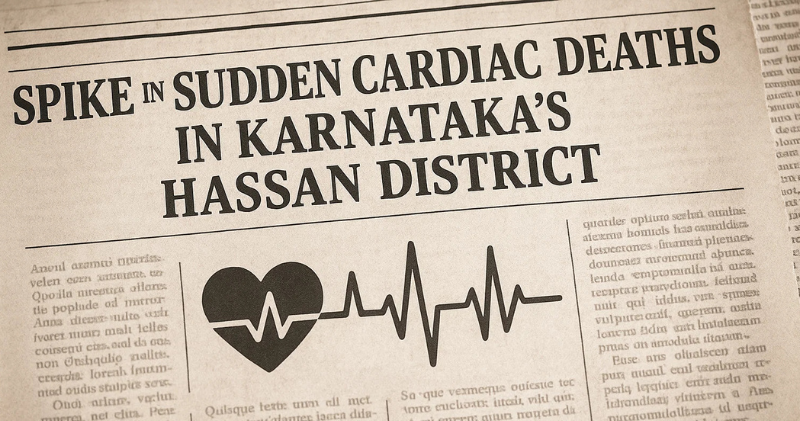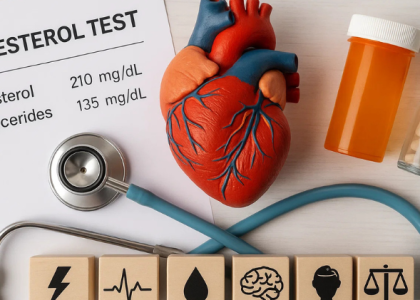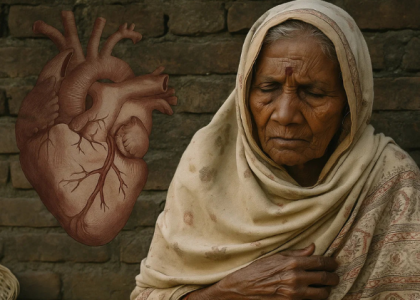Alarming Reports
Between May and June 2025, Karnataka’s Hassan district recorded 22-24 sudden deaths within a span of 40 days.
Most of the victims were under the age of 45, including individuals as young as 19, 21, and early 30s [1].
Government Response
The spike prompted the Karnataka government to appoint a six-member medical committee led by Dr. C. N. Ravindranath of Jayadeva Institute to investigate the deaths [2].
Age Profile of the Victims
The spike in deaths was especially alarming because of the age group affected. – Total deaths reported: 22-24 within 40 days – Young deaths (under 45 years): 14 individuals – Youngest victims: Age 19, 21, 23 – Others in their 30s and early 40s.
Many victims were working professionals and auto/cab drivers – Several had no prior cardiac history – raising concern over silent risk factors This profile highlights the growing threat of premature heart disease in younger populations, especially among those facing lifestyle stress, poor diets, lack of exercise, and unrecognized hereditary risks.
What the Findings Say
The committee examined 24 deaths. – 10 were confirmed cardiac deaths based on ECG reports, autopsies, or medical histories. – 10 were considered probable cardiac based on symptoms or known risk factors. – 4 were unrelated to heart issues, attributed to causes like kidney failure, electrocution, road accidents, and infections [3].
Statistically, the number of cardiac deaths was not higher than the same period in previous years, nor was it significantly different from other districts like Bengaluru or Mysuru [4].
Risk Factor Profile
The most striking detail was the high percentage of victims with known risk factors: – 8 had obesity – 8 consumed alcohol regularly – 7 had diabetes – 6 had high blood pressure – 6 were smokers – 3 had a family history of heart disease or previous cardiac events [5] Occupational background also played a role – nearly 30% of the victims were auto or cab drivers, indicating a strong link to sedentary lifestyles and chronic stress [6].
Systemic Issues
A major limitation was that many victims did not reach a hospital or undergo a formal autopsy, leaving some gaps in definitive cause-of-death classification [7].
Public Health Actions Underway
In response, the Karnataka government has announced several urgent steps: – Mandatory post-mortems for all sudden deaths – ECG machines and cardiac emergency kits in Primary and Community Health Centres – CPR and AED training in schools and public spaces – Expanded screening programs for youth and high-risk occupations – Health education in schools and public awareness campaigns [8]
COVID-19 Vaccine Clarification Authorities firmly ruled out any link between the spike and COVID-19 vaccines. This is consistent with findings from ICMR, AIIMS, CDC, and WHO – all of which show no causal connection between vaccines and sudden cardiac deaths [9].
What This Means for South Asians
Prevention must start early: Many victims were in their 20s and 30s. – Lifestyle factors are key: Obesity, stress, and tobacco are major risks. – Occupational risks matter: Long hours, poor sleep, and limited movement are red flags.
Emergency response gaps must be closed: Timely CPR, AED access, and screening save lives. – Data matters: Mandatory post-mortems and better health record keeping will help prevent future deaths.
Key Takeaways
Point | Detail | |||
| Cases Examined | 24 deaths in 40 days | |||
| Confirmed Cardiac Deaths | 10 | |||
| Probable Cardiac | 10 | |||
| Non-Cardiac Causes | 4 | |||
| Young Age Group Affected | 14 under 45 years | |||
| Common Risk Factors | Obesity, alcohol, diabetes, smoking, high BP |
Sources
1. https://www.hindustantimes.com/cities/bengaluru-news/sudden-heart-attack-related-deaths-in-karnatakas-hassan-touch-22-most-victims-under-45-101751615000515.html
2. https://www.hindustantimes.com/india-news/22-die-due-to-heart-attack-related-problems-in-40-days-in-karnatakas-hassan-panel-to-probe-cause-formed-101751598159513.html
3. https://www.thehindu.com/news/national/karnataka/hassan-heart-attack-deaths-only-10-of-24-reported-during-may-june-are-confirmed-cardiac-deaths-75-of-deceased-had-known-risk-factors/article69796223.ece
4. https://www.thehindu.com/news/national/karnataka/hassan-heart-attack-deaths-only-10-of-24-reported-during-may-june-are-confirmed-cardiac-deaths-75-of-deceased-had-known-risk-factors/article69796223.ece
5. https://www.hindustantimes.com/cities/bengaluru-news/sudden-heart-attack-related-deaths-in-karnatakas-hassan-touch-22-most-victims-under-45-101751615000515.html
6. https://www.newindianexpress.com/states/karnataka/2025/Jul/10/one-third-of-sudden-heart-attack-deaths-in-karnatakas-hassan-were-auto-cab-drivers
7. https://www.hindustantimes.com/india-news/22-die-due-to-heart-attack-related-problems-in-40-days-in-karnatakas-hassan-panel-to-probe-cause-formed-101751598159513.html
8. https://indianexpress.com/article/cities/bangalore/hassan-cardiac-deaths-study-rules-out-sudden-increase-10118773/
9. https://www.indiatoday.in/india/karnataka/story/no-link-spike-heart-attacks-covid-vaccine-siddaramaiah-claim-karnataka-government-probe-2753779-2025-07-10




